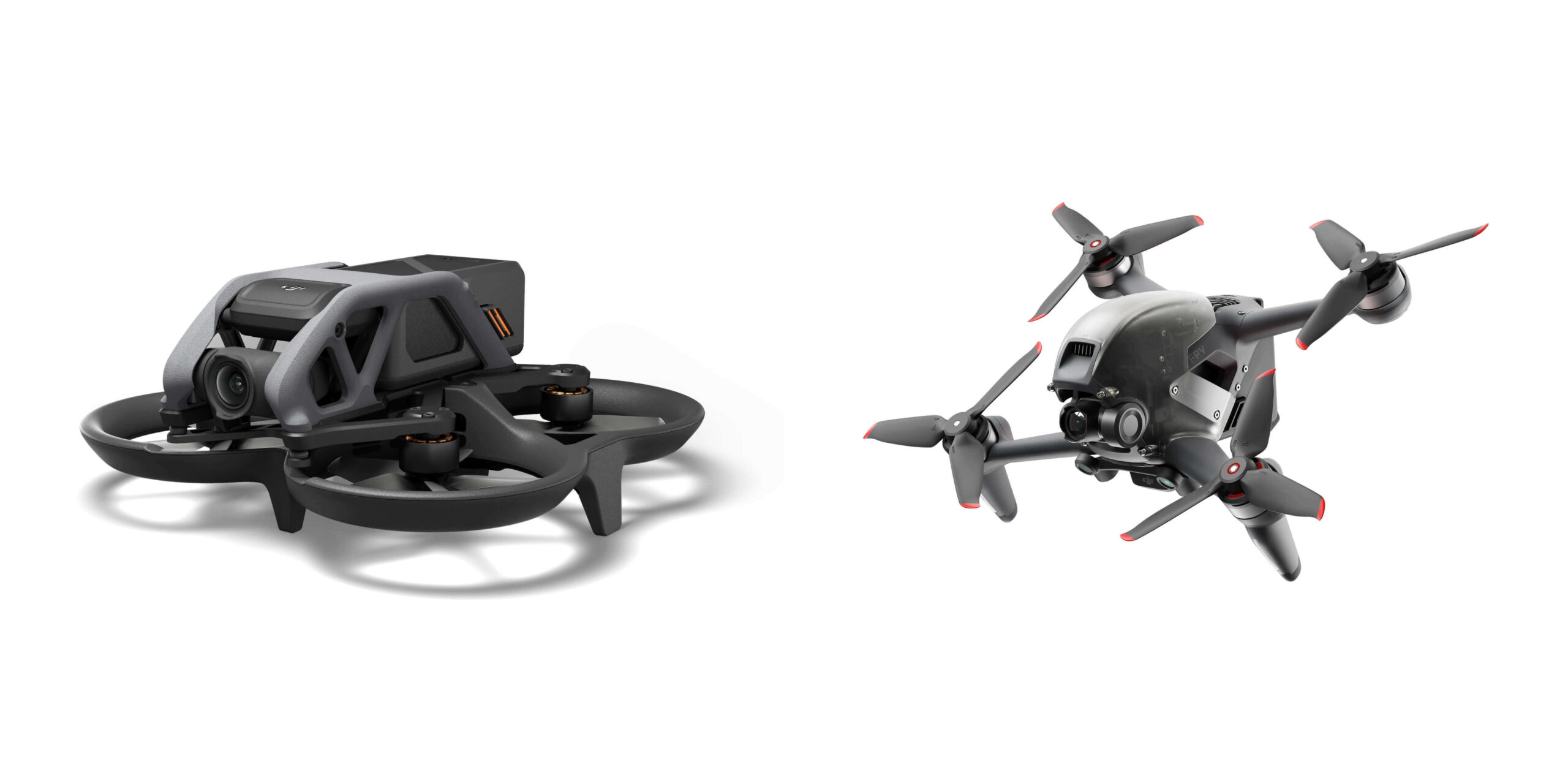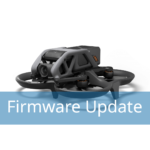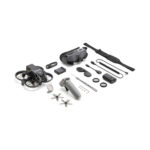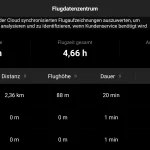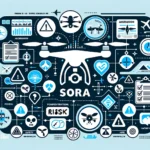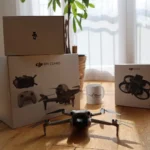In the following comparison, we contrast the DJI Avata with the DJI FPV drone. Which drone is better? For whom is which model suitable? We have the answers.
With the Avata, DJI released its second ready-to-fly FPV drone in August 2022. The first model, the DJI FPV, was already released in 2021, but what are the differences between the two FPV drones? We compare the technical data, provide the advantages and disadvantages, and give you a personal conclusion for a purchase recommendation.
Technical data in comparison
The following table contains the most important technical data of both drones in a direct comparison. We will then tell you where the advantages and disadvantages of both drones lie, before we draw a conclusion.
| DJI Avata | DJI FPV | |
|---|---|---|
| Preis (Drohen ohne Zubehör, laut DJI Store) | 579€ | 719€ |
| Abfluggewicht | ca. 410g | ca. 795g |
| Max. Flugzeit | ca. 18 Minuten | ca. 20 Minuten |
| Max. Fluggeschwindigkeit | 97,2 km/h (M-Modus) | 140 km/h (M-Modus) |
| Max. Starthöhe | 5.000m | 6.000m |
| Betriebstemperatur | -10° bis +40°C | -10 °C bis +40 °C |
| Interner Speicher | 20 GB | - |
| Kamera | ||
| Sensor | 1/1,7″ CMOS Effektive Pixel: 48 MP | 1/2,3” CMOS Effektive Pixel: 12 MP |
| Objektiv | Sichtfeld: 155° Äquivalente Brennweite: 12,7 mm Brennweite: 2,34 mm Blende: f/2,8 Fokusmodus: Fixfokus Fokusbereich: 0,6 m bis ∞ | Sichtfeld: 150° Entspricht im 35-mm-Format: 14,66 mm Blende: f/2.8 Fokusmodus: Festbrennweite Fokusbereich: 0,6 m bis ∞ |
| ISO-Bereich | 100 bis 6400 (Autom.) 100 bis 25600 (Manuell) | 100 – 12800 |
| Belichtungszeit | Video: 1/8000 bis 1/50 s Foto: 1/8000 bis 1/50 s | 1/50 – 1/8.000 s |
| max. Bildauflösung | 4000 × 3000 | 3840 × 2160 |
| Videoauflösung | Mit DJI Goggles 2: 4K mit 50/60 fps 2.7K mit 50/60/100 fps 1080p mit 50/60/100 fps Mit DJI FPV Goggles V2: 4K mit 50/60 fps 2.7K mit 50/60/100/120 fps 1080p mit 50/60/100/120 fps | 4K: 3840×2160 bei 50/60 fps Full HD: 1920×1080 bei 50/60/100/120 fps |
| Video-Format | MP4 | MP4/MOV (H.264/MPEG-4 AVC, H.265/HEVC) |
| Max. Video-Bitrate | 150 MBit/s | 120 MBit/s |
| Farbprofil | Standard D-Cinelike | Standard D-Cinelike |
| Gimbal | ||
| Mechanischer Bereich | Neigen: -95° bis 75° | Neigen: -65° bis 70° |
| Steuerbarer Bereich | Neigen: -80° bis 65° | Neigen: -50° bis 58° |
| Stabilisierung | Einachsig (Neigen) | Einachsig (Neigen), Rollachse (elektronisch) |
| Max. steuerbare Geschwindigkeit | 60°/s | 60°/s |
| Elektronische Rollachse | Die Echtzeit-Bildschirmkorrektur ist während der Aufnahme nicht verfügbar, kann aber auf das mit der Drohne aufgenommene Filmmaterial angewendet werden. | Ja (kann das Filmmaterial stabilisieren, wenn das Fluggerät in einem Winkel von bis zu 10° geneigt ist) |
| Akku (Intelligent Flight Battery) | ||
| Kapazität | 2.420 mAh | 2.000 mAh |
| Erkennungssystem | ||
| Unten | Effektive TOF-Messhöhe: 10 m Präziser Messbereich: 0,5 bis 10 m Erfassungsreichweite: 0,5 bis 20 m | TOF Effektive Erfassungshöhe: 10 m Schwebebereich: 0,5 – 15 m Schwebebereich der Sichtsensoren: 0,5 – 30 m |
| Vorwärts | - | Präzisionsmessbereich: 0,5 – 18 m Hinderniserkennung: Nur im N-Modus verfügbar; Sichtfeld: 56° (horizontal), 71° (vertikal) |
Advantages and disadvantages
Compared to the DJI FPV, the Avata has a significantly lower weight. The Avata achieves this through a much more compact design, which makes the drone less susceptible to collisions. The propellers, which come with protection out of the box, also contribute to this. In the event of a crash, the chances are significantly higher that the DJI Avata will survive the whole thing without damage. With the DJI FPV, it usually looks rather bad here.
The more compact design also gives the DJI Avata additional options during flight, making it even more agile than its predecessor. In terms of flight modes, both models rely on the familiar N (Normal), S (Sport) and M (Manual) modes.
Due to the smaller size and the standard propeller protection, the DJI Avata is also very suitable for indoor flights. Here you have a much harder time with the DJI FPV.
With the Avata, DJI also relies on a better camera. Here, compared to the DJI FPV, something was upgraded.
If you’re looking for maximum speed, the DJI FPV has a whopping 50 km/h more top speed. According to the specifications, the Avata reaches a little over 97 km/h, while the DJI FPV reaches up to 140 km/h.
In terms of maximum flight time, both models have little in common, although the FPV is slightly ahead here (20 minutes for the FPV versus 18 minutes for the Avata).
For control, both drones use the same technology consisting of FPV remote control or motion controller, as well as the Goggles video goggles. For the release of the Avata DJI also packs a new version of the Goggles in the package – the Goggles 2 (danger of confusion with the predecessor V2!). However, the Avata can also be controlled with an existing Goggles V2. The video goggles are not part of the comparison. All technical data can be found on the official DJI site.
Offers
- Gewicht 410g
- 4k 60 FPS Videos
- 18 Minuten Flugzeit
- Fluggeschwindigkeit bis zu 97,2 km/h
- Wendige kleine FPV Drohne, neue Goggles 2 und vieles mehr!
- Beeindruckendes Flugerlebnis
- 4K-Videoauflösung
- 20 Minuten Flugzeit
- Sofort lieferbar
- kostenloser Versand
Conclusion
So for whom is which FPV drone suitable? In our opinion, the DJI Avata is the FPV drone that the DJI FPV should have been in the first place. The smaller dimensions, the propeller protection, the better camera, useful features like the turtle mode that allows the DJI Avata to right itself after a crash and last but not least the lower price make the DJI Avata in our eyes the better FPV package as you would expect. The only notable advantage we see with the DJI FPV is the significantly higher maximum speed and the minimally longer flight time.
FAQ – Avata and FPV comparison
In terms of technical data, the DJI Avata is slightly ahead in our opinion. All data can be found in the article.
In the DJI Store, prices start at 579€.
In the DJI Store, prices start at 719€.
Weighing 410g, the DJI Avata is significantly lighter than the DJI FPV at 795g.
*The links contained in this article are so-called affiliate links. With these links DeinDrohnenpilot.de gets a commission for mediated purchases. The price does not increase for the customer.
Letzte Aktualisierung am 2025-03-31 / Affiliate Links / Bilder von der Amazon Product Advertising API


